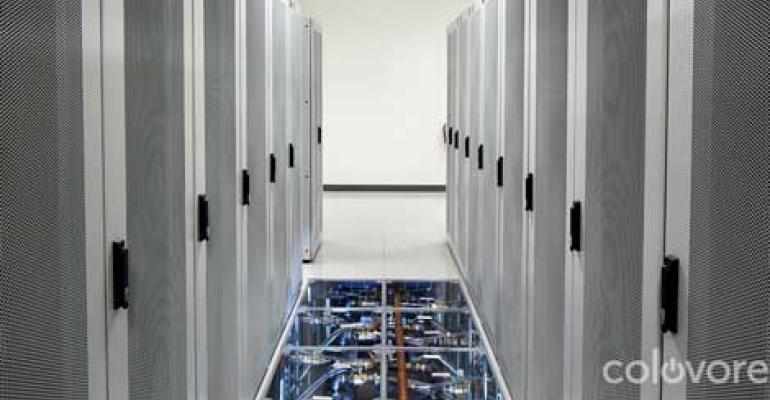In the midst of Silicon Valley's busiest data center neighborhood, the air is fine. But the water is even better.
That's the approach being taken by Colovore, a colocation startup that is the newest arrival on the scene in Santa Clara, the data center capital of Silicon Valley. Seeking to find the best combination of high density and efficiency, Colovore is offering water-cooled cabinets that can support power loads of up to 20 kilowatts (kW). Each cabinet is equipped with a rear-door heat exchanger which uses cool water to remove heat as waste air flows through the back of the enclosure.
This cooling strategy allows Colovore to differentiate itself in a crowded regional market in which virtually every major player in the industry is offering data center space. It also provides the best bang for the buck in the company's facility at 1101 Space Park Drive, where it has a modest footprint (24,000 square feet) but 9 megawatts of power.
Colovore launched last August and opened its doors in December. The company says it is seeing traction with two types of clients: companies focused on high-performance computing (HPC) and customers that are refreshing their IT hardware and looking to pack more servers into fewer cabinets.
Hardware refreshes drive consolidation
Colovore President and co-founder Sean Holzknecht says more companies in Silicon Valley are finding that as servers get more powerful, new equipment is pushing the boundaries of their existing data center. He says that's true for in-house data centers, but also for some colocation facilities using traditional air cooling.
"Many of these companies can move into half as many racks in Colovore," said Holzknecht. "Everyone is scrambling to build high-density islands in low-density data centers. We're seeing interest from companies that are consolidating, but don't need a footprint that's gigantic."
Holzknecht knows the Bay Area market from his previous post as vice president of operations at Evocative, the Emeryville provider that was acquired by 365 Main last year. CTO Peter Harrison arrives from Google, where he was a senior technical program manager on the data center team. CFO Ben Coughlin brings experience in the private equity sector, where he worked with Camden Partners and Spectrum Equity.
The Liebert rear-door heat exchangers can support up to 12kW per cabinet, according to Mehrdad Alipour, mechanical engineer at Therma Corporation in San Jose, which supported the Colovore project. The rear door unit uses air that is "tempered" rather than mechanically chilled, typically circulating at temperatures between 62 and 76 degrees. The cooling capacity can be boosted to 20kW per cabinet when supplemented by Liebert CRV in-row-cooling units, and the company is developing a design to support densities of up to 40kW per rack.
"Our expectation was that in 2014 we would see 10kW per cabinet and then we would expect that number would rise over the next five years," Holzknecht said. But that trend line has been accelerated by several HPC projects that are already running as high as 17kW per cabinet.
High-efficiency UPS system
Dave Smith, a principal at ECOM Engineering, noted that the Colovore facility is designed to allow customers with different loads to be hosted comfortably within the same data hall. "The way the mechanical piping is configured, it doesn't change between a 5kW or 10kW or 15kW cabinet," said Smith. "The heat output is the same for the 20kW rack as it is for the 10kW rack."
Colovore is also using a high-efficiency UPS system that operates in "eco mode", foregoing the traditional double-conversion UPS approach with a configuration that offers better efficiency but slightly less redundancy. Smith said Colovore provides a good example of an environment in which eco-mode is appropriate, since it is adjacent to a substation for the local utility.
"You have to look at where you are and the reliability of the grid," said Smith. "We're right next to Silicon Valley Power. Our reliability is really high, so the need to go to double-conversion really isn't there. Of course, it's supported if that's what the customer needs.
"The days of fear and overbuilding are gone. Now it's about optimizing for efficiency. We're not layering belts and suspenders on top of belts and suspenders."
Colovore is starting out with 2 megawatts of power and will add capacity in increments of 1.2 megawatts to 1.8 megawatts, installing skids of electrical and mechanical gear as needed to support additional IT space.
The Colovore team acknowledges the competitive nature of the market in Santa Clara, where DuPont Fabros just commissioned 9 megawatts of new capacity. Holzknecht says there's plenty of demand to support many providers and different approaches to the market.

A row of cabinets inside the Colovore data center in Santa Clara, Calif. Each cabinet is equipped with a rear-door heat exchanger using tempered water.





